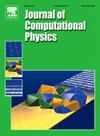用Onsager变分原理求解多孔介质方程的动网格法
IF 3.8
2区 物理与天体物理
Q2 COMPUTER SCIENCE, INTERDISCIPLINARY APPLICATIONS
引用次数: 0
摘要
本文以Onsager变分原理为近似框架,提出了一种求解多孔介质方程的移动网格有限元方法。我们首先证明了用Onsager原理可以推导出连续问题的混合公式。随后,我们通过在具有自由节(可移动节点)的非线性有限元空间中逼近问题,遵循相同的变分方法,开发了几种数值格式。我们严格地证明了在半离散和全隐式离散格式下能量耗散结构是保持的。此外,我们还提出了一种完全解耦的显式格式,该格式每个时间步只需要几个线性方程的顺序解。还可以类似地推导出该方法的其他变体,以保持质量守恒或增强稳定性。当仔细选择初始网格以确保良好的初始数据逼近时,数值格式的收敛速度最佳。通过大量的数值实验,我们评估并比较了所提出方案与现有方法的效率和稳定性。在初始网格均匀的情况下,所有方案均表现出良好的稳定性,其中完全解耦方案的计算效率更高。相比之下,在处理非均匀网格上的奇异问题时,稳定的显式格式在稳定性和计算效率之间取得了很好的平衡。此外,该方法在不需要用户干预的情况下固有地捕获了等待时间现象,进一步说明了其鲁棒性。本文章由计算机程序翻译,如有差异,请以英文原文为准。
A moving mesh method for porous medium equation by the Onsager variational principle
In this paper, we present a novel moving mesh finite element method for solving the porous medium equation, using the Onsager variational principle as an approximation framework. We first demonstrate that a mixed formulation of the continuous problem can be derived by applying the Onsager principle. Subsequently, we develop several numerical schemes by approximating the problem within a nonlinear finite element space with free knots (movable nodes), following the same variational approach. We rigorously prove that the energy dissipation structure is preserved in both semi-discrete and fully implicit discrete schemes. Additionally, we propose a fully decoupled explicit scheme, which requires only the sequential solution of a few linear equations per time step. Other variants of the method can also be derived analogously to preserve mass conservation or to enhance stability. The numerical schemes achieve optimal convergence rates when the initial mesh is carefully chosen to ensure good approximation of the initial data. Through extensive numerical experiments, we evaluated and compared the efficiency and stability of the proposed schemes with existing approaches. For cases involving uniform initial meshes, all schemes exhibit good stability, with the fully decoupled scheme demonstrating superior computational efficiency. In contrast, when addressing singular problems on nonuniform meshes, the stabilized explicit scheme strikes a good balance between stability and computational efficiency. In addition, the method inherently captures the waiting time phenomenon without requiring user intervention, further illustrating its robustness.
求助全文
通过发布文献求助,成功后即可免费获取论文全文。
去求助
来源期刊

Journal of Computational Physics
物理-计算机:跨学科应用
CiteScore
7.60
自引率
14.60%
发文量
763
审稿时长
5.8 months
期刊介绍:
Journal of Computational Physics thoroughly treats the computational aspects of physical problems, presenting techniques for the numerical solution of mathematical equations arising in all areas of physics. The journal seeks to emphasize methods that cross disciplinary boundaries.
The Journal of Computational Physics also publishes short notes of 4 pages or less (including figures, tables, and references but excluding title pages). Letters to the Editor commenting on articles already published in this Journal will also be considered. Neither notes nor letters should have an abstract.
 求助内容:
求助内容: 应助结果提醒方式:
应助结果提醒方式:


